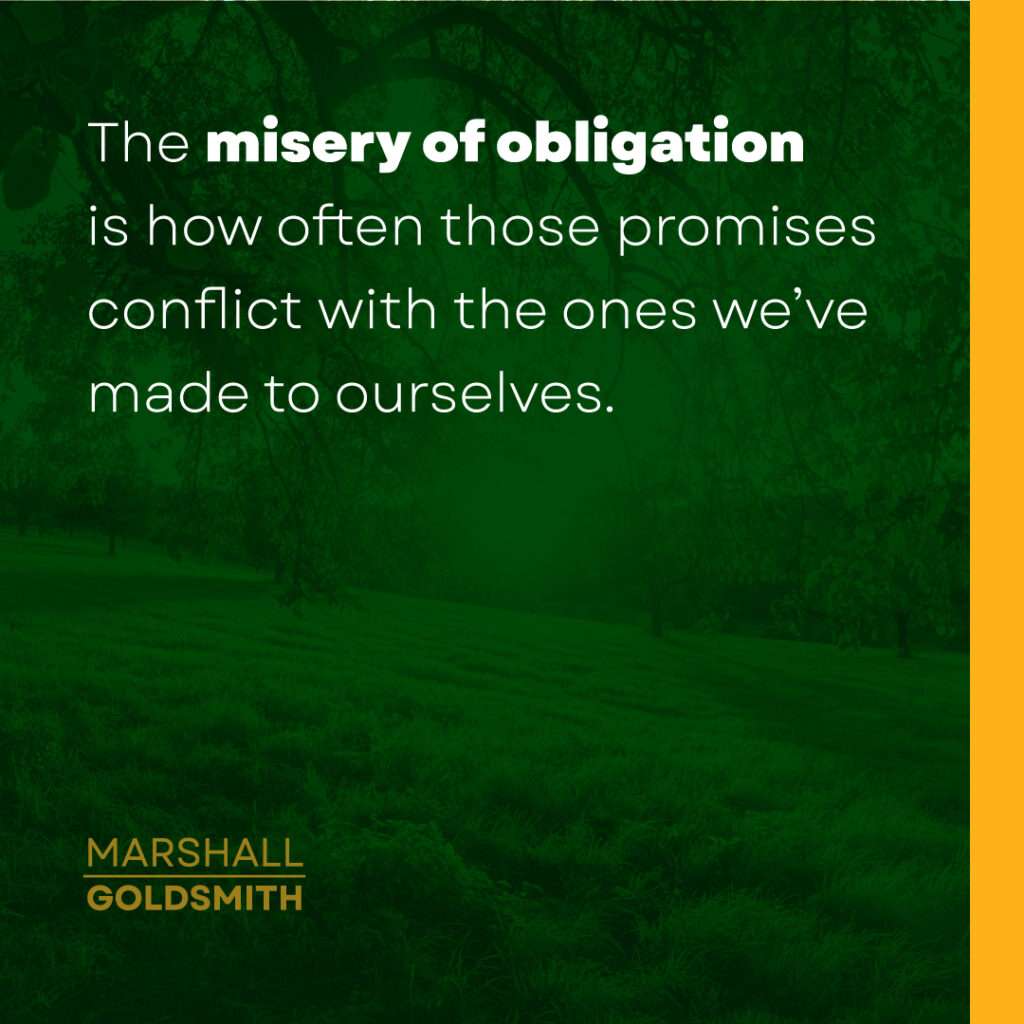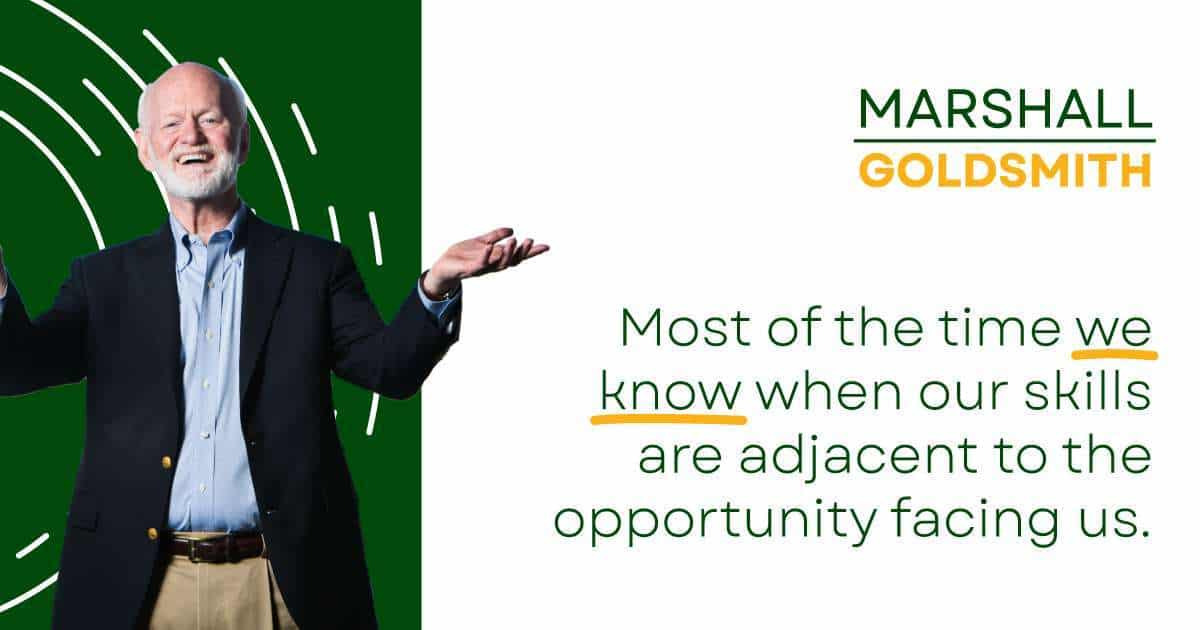Playing Favorites By Marshall Goldsmith There’s a reason I devote...
Success isn’t simply desire, talent, intellect, and self-belief. You need support, as well as a receptive market for each of your specific tasks or goals.
Many personal assets improve your chances for success, such as creativity, discipline, resilience, empathy, humor, gratitude, education, timing, likability, and so on. I’ve identified six considerations for success: motivation, ability, understanding, confidence, support, and the marketplace.
If motivation, ability, understanding, confidence, support, and marketplace, all operating in alignment, are must-have factors, then adjacency is a nice-to-have factor.
A successful photographer can make a midlife conversion to cinematographer or director, but they probably can’t remake themselves into a brain surgeon. Cinematography and directing are adjacent in ability and understanding to photography (working with cameras, people, and ideas); neurosurgery is not. That’s what makes adjacency an interesting consideration when we run through the checklist for creating an earned life.

When we are frustrated with our life or career and we yearn for something more gratifying, it may be emotionally soothing to imagine a life that’s 180 degrees removed from our current predicament. But the odds of success favor the people who do not stray too far from their expertise, experience, and relationships. That doesn’t mean we’re restricted to small and incremental changes in our lives. The change can be huge. But it requires adjacency—some connection, however indirect, to our track record of accomplishment.
Jim Yong Kim is the biggest brain I know. He has an M.D. and a Ph.D. in anthropology from Harvard, and he’s an expert in global health and infectious diseases, co-founder of Partners in Health, department chair at Harvard Medical School, director of the World Health Organization’s HIV vs. AIDS division, the recipient of a MacArthur
“Genius Grant,” perennially included in annual lists of influential leaders. This explains why, in 2009, as Dr. Jim turned fifty, Dartmouth College wanted him to be its next president.
Dr. Jim and I discussed the pros and cons of this opportunity. At Dartmouth, he’d be dealing with faculty, donors, and a notoriously fractious student body, quite a departure from a life spent tackling public health crises. On the other hand, he’d succeeded at everything he’d ever tried. He wouldn’t be away from home so much. It would be a good base for his family of two young boys. And he was familiar with academic life in the Ivy League. I urged him to take it. It would be an interesting challenge.
What I forgot to consider was adjacency – was there enough in the job that played to his scientific expertise and would motivate him the way his previous roles did? He could handle the job, but while he loved Dartmouth and its students, he wasn’t using all his talents.
Three years into his presidency at Dartmouth, the World Bank asked him to take over its mammoth organization in Washington, D.C.
Again, we discussed the pros and cons. At first glance, running the World Bank sounded like an even greater leap into nonadjacency than a university presidency. Jim knew very little about international finance.
But the World Bank is not a financial institution like JPMorgan Chase. It is a global partnership that distributes money to developing nations to eradicate poverty. Global. Partnership. Poverty. These words defined Jim’s life.
In Jim’s mind, poverty and public health crises weren’t merely adjacent. They were one and the same. If he took the job, he could redirect the World Bank’s mission to reduce poverty by waging war on specific diseases that attack the most vulnerable people. This time I didn’t have to convince him to make the move. He knew it was in his personal and professional wheelhouse. As a result of his seven years at the World Bank, it’s estimated that programs he’s been associated with have saved twenty million lives. I’d sacrifice a limb or two to have that on my résumé.
Most of the time we know when our skills are adjacent to the opportunity facing us.
Adjacency is an elusive concept only when our next opportunity sounds like a stretch—an uncharted departure from who we used to be and who we’d like to become. But if the adjacency exists and we find it, the stretch soon makes perfect sense.
To discover your adjacency to the life you are creating, you have to find one asset in yourself that is essential for success in your new life. For example, there was a time fifty years ago when a professional athlete or coach moving into the sports broadcast booth after retirement sounded like a stretch. Not anymore, once TV executives realized that athletes really knew their sport and had credibility talking to fellow athletes on camera. The adjacency was the ballplayers’ savviness about their sport—their mastery of the content—not their on-air delivery, which could be learned on the job.
Here is what to do: List the twenty or so people in your career with whom you communicate most frequently over, say, a three-month period.
Is there one standout skill or personal quality that you share with the people you listed whom you most admire?
If so, is it the kind of skill that can take you far in a totally different field? That is, does who you want to become match up with who you already are?
Being a creative director at an advertising agency may not seem at first like the perfect training for becoming a screenwriter, but it makes perfect sense when you appreciate the two roles’ adjacency: They both require a gift for storytelling.
It’s the same with salesmanship. If you have the ability to sell, you have adjacency to any career that requires persuasion and making people part with their money. Once you appreciate the quality that distinguishes you from other people, you begin to see all the opportunities where that skill might come in handy.
Adjacency dramatically expands your professional and personal options.

Adding Too Much Value Won’t Get You There By Marshall...
C-Suite Master Class: No, But, However By Marshall Goldsmith Continuing...
The Doerr Institute: Expanding the Market for Coaches By Marshall...
Making Leadership Development Part of the College Degree at Rice...
Sanyin Siang – Winner of the Thinkers50 Marshall Goldsmith Coaching...
Thinkers50 Marshall Goldsmith Distinguished Achievement Award in Coaching – Nominees...
Leading with Influence: What Is Influence360°? By Marshall Goldsmith Founder...
Are You a Dominator, Manipulator, Persuader or Influencer? By Marshall...
Leading with Influence: Redefining Modern Influence Part 2 By Marshall...
My mission is simple. I want to help successful people achieve positive, lasting change and behavior; for themselves, their people, and their teams. I want to help you make your life a little better. With four decades of experience helping top CEOs and executives overcome limiting beliefs and behaviors to achieve greater success, I don’t do this for fame and accolades. I do this because I love helping people!
As an executive educator and coach, I help people understand how our beliefs and the environments we operate in can trigger negative behaviors. Through simple and practical advice, I help people achieve and sustain positive behavioral change.